The main goal of a PPC Campaign is to generate profit. If that goal is not achieved, then you should take the correct decision and stop your campaigns because you are simply losing your money.
This is a very basic principle that every business owner should follow, whether it’s PPC campaigns on AdWords, Facebook Paid ads, LinkedIn Ads or any other platform.
Don’t get me wrong, a PPC campaign can be profitable. In fact, it’s one of the best ways to grow your business fast.
The problem is that running profitable PPC campaigns, is not always so easy. If you fall into the trap believing that you can make money with PPC by just setting up a campaign and let it run on ‘auto-pilot’, then it’s like throwing your money in a black hole.
Proper PPC management needs to be planned correctly. The process begins before creating your campaigns on AdWords and continues as long as the campaigns are generating a positive ROI.
More than 1 Million Dollars Managed on AdWords the last 2 years
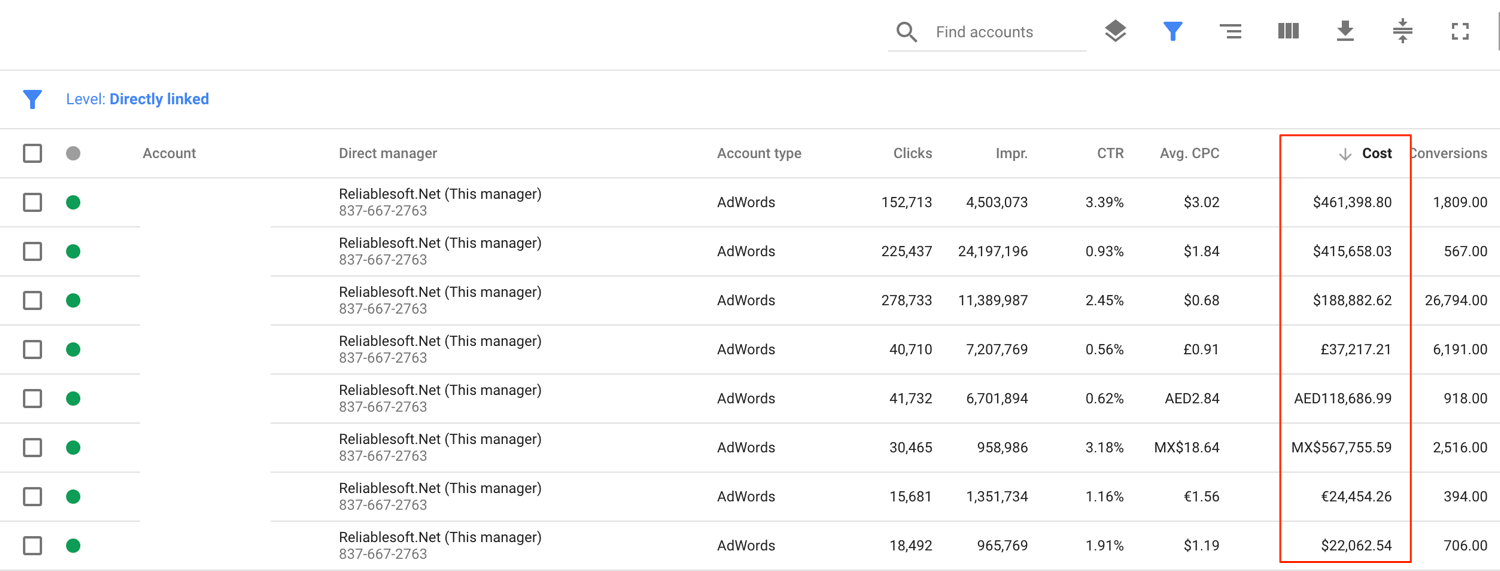
As a certified Google AdWords Partner, we manage a number of PPC campaigns for our clients. The last two years, the total ad spend was more than 1 million USD.
Obviously, the return on investment was bigger than that, and this is the reason our clients increased their spending to those levels.
Our experience with AdWords goes back even more years and my goal with this post is to share with you the lessons learned and help you understand how to launch, setup and manage profitable PPC campaigns.
For those new to AdWords and PPC, let me just mention that Paid Search Advertising (PSA) is one of the components that make up SEM (Search Engine Marketing). The other component is SEO (Search Engine Optimization).
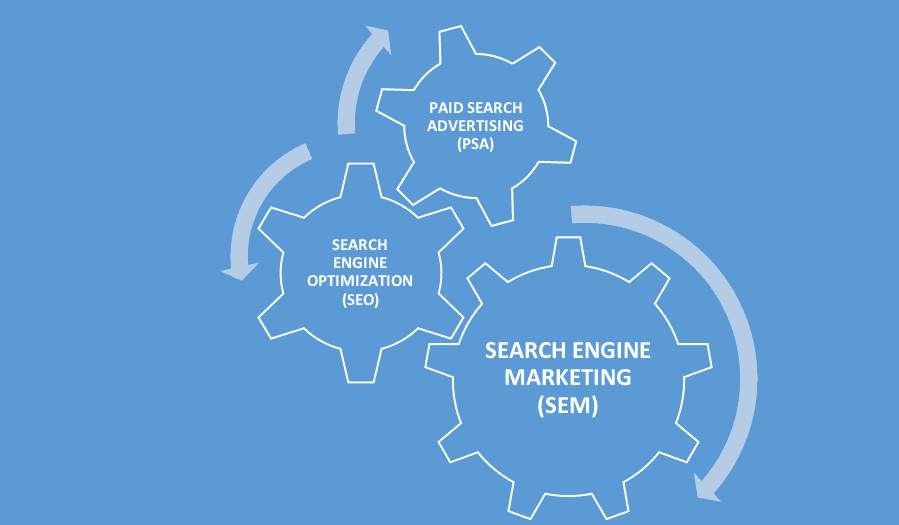
What is a profitable PPC Campaign?
Before we get into the details on how to improve the performance of your campaigns, let’s clear out what do we mean by profitable PPC campaigns.
A profitable PPC campaign is the one that generates a positive Return on Investment (ROI).
The Return On Investment (ROI) is usually calculated as:
ROI = (Revenue – Cost of goods sold) / Cost of goods sold.
In this case the cost of goods sold should include AdWords costs (i.e. ad spend and management fees).
For example, let’s say you have a product that costs $50 to produce, and sells for $100. You run a PPC Campaign on AdWords and sell 10 products per month.
Your total sales are $1000, your AdWords Costs are $250 (Ad spent and management fees).
Your ROI is ($1000-($500+$250)) / ($500+$250) = 33%.
In this case you are making profit from AdWords.
The point I want to make here is that when calculating the profitability of an AdWords campaign, you should not only take into account the Advertising and management fees but also other costs.
Likewise, you should also include in your calculations indirect benefits gained from running a Google campaign like sales or leads generated because of the exposure you have with AdWords.
Consider the example below. The total online sales were $250 but because of the indirect benefits offered by AdWords, the company generated an additional $200 in sales. This should also be included in your calculations in order to arrive at an accurate figure.

Don’t overlook this step because if you don’t have a valid way to calculate the true return from the investment made on PPC, it will be difficult to decide if this a profitable channel for your business.
15 Lessons Learned After Spending $1 Million on Google Adwords
Follow the 15 best practices below to increase your chances of succeeding with AdWords.
1. Create a plan with goals and milestones
Planning is important when running PPC Campaigns. Before creating your campaigns in AdWords, you should create a plan with specific goals and milestones.
Your initial plan should include things like:
- The ideal number of conversions per month
- The ideal cost per conversion
- The ideal cost per click
- Max budget to use per day
- Total monthly budget
- The type of campaigns to setup first and the tests to perform
- Ideas of what campaigns/ads/bidding strategies should be tested throughout the lifetime of a campaign.
You can create your plan in an excel spreadsheet and then use the same spreadsheet to monitor the performance of the campaigns on a monthly basis.
Our spreadsheet besides the initial plan includes a sheet for monitoring purposes and a sheet for each campaign that we write (among other things), ad ideas and a log of all changes made to the campaign and the effect on CPC (cost per click), CTR (click through rates) and conversions.
2. Structure your account correctly
It is important to structure your account is a way that is easy to manage. If you have a couple of campaigns then that’s not an issue but as you expand your reach and create more campaigns, the account needs to have a proper structure.
Best practices for account structure include:
Create country specific campaigns – If you are running campaigns in more than one countries, it is recommended to have one campaign per country. This way you will be able to set separate budgets and have better control on targeting.
Create campaigns matching your site structure / products – This is basic but important. Your account structure should ‘replicate’ the structure of your website as much as possible.
Separate Campaigns for Display / Search / Remarketing – Each campaign should have a unique goal and it’s recommended to use different campaigns for search traffic, display or display remarketing.
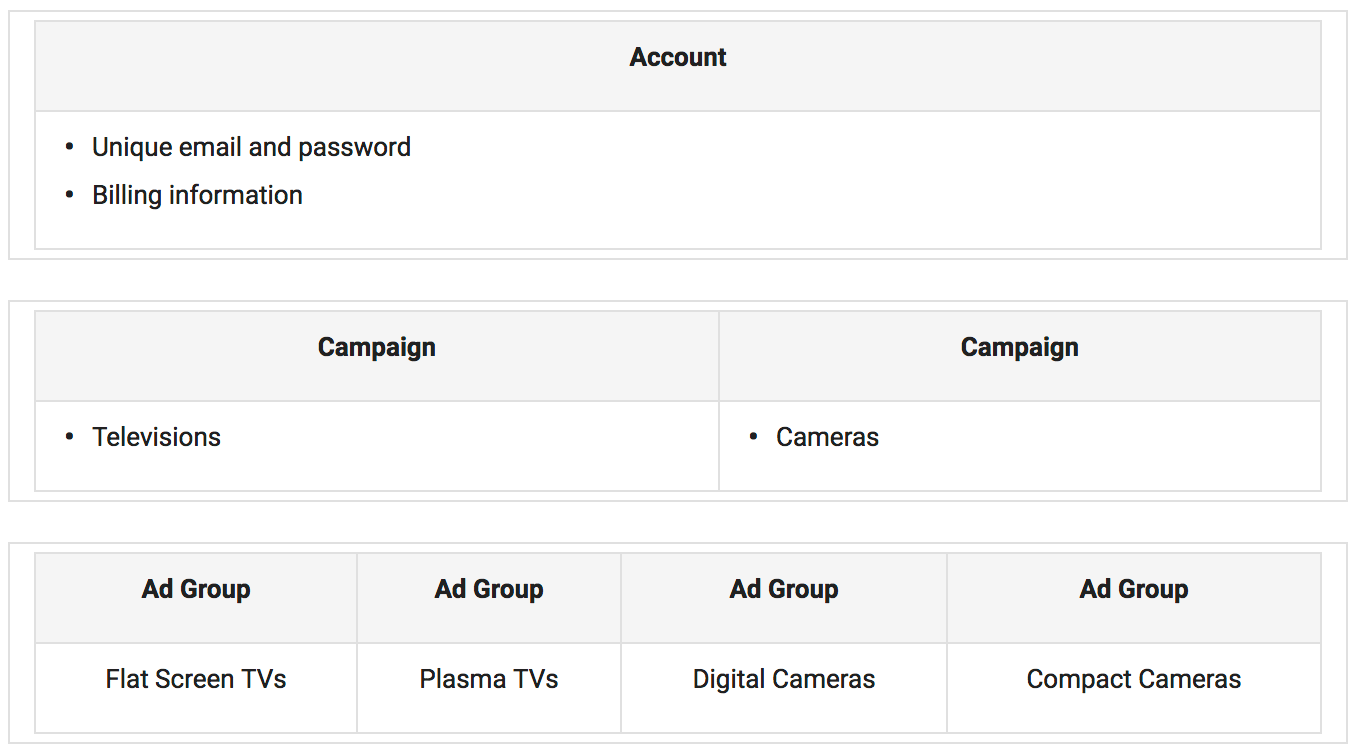
3. Create themed ad groups
What do we mean by themed ad groups? That keywords in an ad group, ads and landing pages have the same theme i.e. they should be very specific.
To make it more clear:
- Keywords in an ad group should have a close relationship. Don’t mix irrelevant keywords in the same ad group. For example, if you are promoting engagement rings, don’t have “solitaire engagement rings” and “round cut engagement rings” in the same ad group. These should be placed in their own ad groups.
- Each ad group should include at least 3 ads. This is officially recommended by Google and a must-follow guideline.
- ALL the keywords in the ad group should be included in at least one of the ads (in either headline 1 or headline 2)
If you have keywords that are not in the ad group ads, you should consider removing those keywords and creating a new ad group.
Themed ad groups increase relevancy, ad rank and lower costs.
4. Start with a low budget and increase gradually
Don’t allocate the max of your daily budget from day 1. Start with a low budget and then increase that gradually depending on how your campaigns perform.
There are a number of advantages of following this approach:
- First, you get a chance to enrich your negative keyword list and avoid spending money on irrelevant clicks.
- Second, you give enough time to AdWords machine learning system to ‘understand’ the objectives of your campaigns and make better ‘recommendations’ and decisions.
- Third, you will be able to make informed decisions as to where you should allocate your budget. Some campaigns will perform better than others and your daily budget should be allocated accordingly.
5. Start with modified broad match keywords and then switch to phrase or exact match
When you start a new PPC campaign, you don’t really know which keywords are the most valuable for your business.
You can perform keyword research when setting up a campaign but at this stage it’s only predictions.
Only when you start the campaigns you can know for sure which keywords (or search queries) perform better than others.
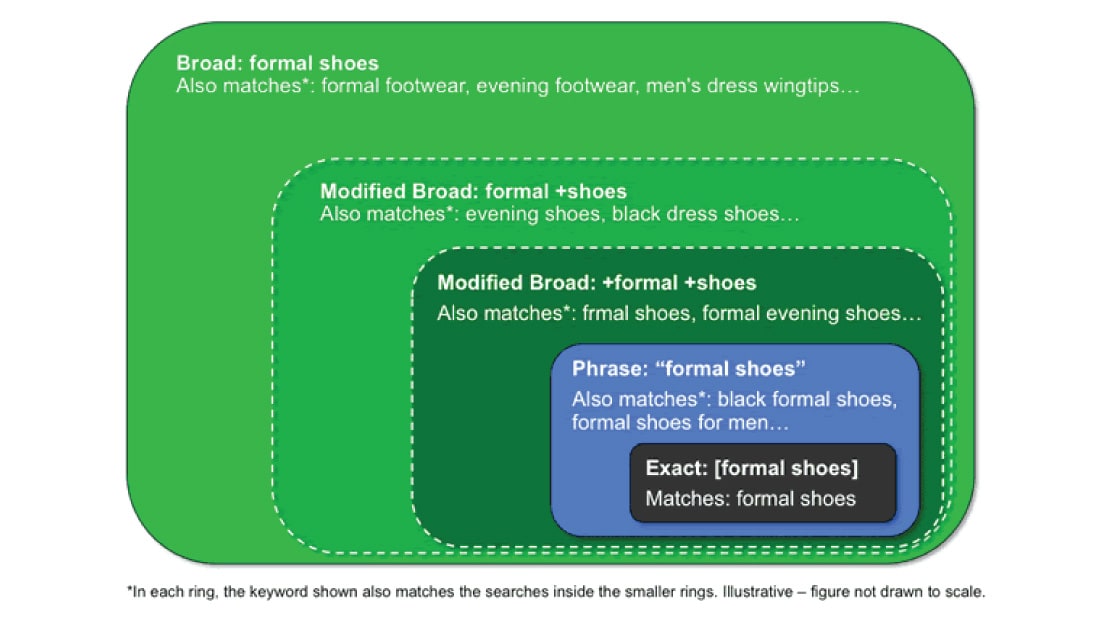
A great way to do this is to start with modified broad match keywords.
When using modified broad match, you will end up with a big list of ‘search terms’ that have actually triggered one of your ads to be shown or clicked.
Run for your campaigns to gather enough data and then duplicate them (pausing the original ones) and change your keyword types based on these rules:
- Search terms that triggered your ads to show – add them as “phrase match keywords”
- Search terms that generated conversions – add them as [exact match keywords]
What is the benefit of doing this?
One of the biggest factor affecting the Cost Per Click (CPC), quality score and ad position is relevancy of your keywords and ads.
By switching to phrase and exact match keywords and making sure that these keywords are also included in your Ad headings, you will dramatically reduce your costs while at the same time increase conversions.
6. Use negative keywords to get rid of junk
Do not underestimate the power of negative keywords. Losing money on clicks that are not related to your products or services is a total waste of money.
Negative keywords are a very powerful tool to make sure that your ads are only shown for the keywords that matter for your business.
My advice is to review the search terms report on a weekly basis and add any irrelevant keywords as negatives using the modified broad match type.
For example, if you are don’t offer any products or services for free, you can add the keyword +free as a negative, to exclude all search terms that include the word free.
This is a more efficient way than adding all combinations as phrase or exact match.
Hint: To make it easier to manage your negatives, use negative keyword lists that can be shared between campaigns.
7. Use the most appropriate bidding strategy
AdWords has a number of options when it comes to bidding strategies. Depending on your goals, you should choose the appropriate type.
This process can be a bit tricky and it will require patience and a lot of testing.
Google has some recommendations about bidding strategies and campaign goals but you should test each one to find out what works better for your niche.

My recommendations are:
- Try to avoid manual bidding. This can get out of hand if you have a lot of campaigns to manage.
- Use Maximize Clicks when running your modified broad match campaigns to get as many clicks as possible and have enough data to analyze in your search queries report.
- Start your phrase and exact match campaigns with maximize clicks and once you get some conversions switch to maximize conversions.
- Use target CPA is you are confident about your ‘ideal’ cost per acquisition.
- Use Target search page location and aim for the top position when you have a promotion campaign running (i.e. a Sale) for a limited duration.
8. Take advantage of ad extensions to increase ad space
Google insists on using all available possible extensions within your ad, for a number of reasons.
- First, it’s a step towards achieving a higher ad rank (which means better ad positions at a lower CPC).
- Second and most important, it increases the space of your ads and makes them more prominent and visible.
Be creative when it comes to the use of extensions and try to use as many extensions as you can. Do some competitor analysis and look at how your competitors are taking advantage of ad extensions and make sure that your ads look more ‘attractive’ in the search results.
9. Don’t always bid for the top position
It is true that ads in the top position receive the most clicks. At the same time, it also costs much more because everybody wants to be in the top position.
My advice is to do some tests and compare your clicks and costs of having your ads in the top position or in a lower position.
What you will find is that if your ads are well formatted with extensions and compelling messages, you can still get a decent number of clicks and conversions but at a much lower cost.
So, don’t always try to get to the top but look for the best way to get what you want (i.e. conversions) while keeping your costs low.
10. Avoid the use of duplicate keywords
Having the same keywords in the same ad group, campaign or account is a bad practice. It not only confuses Google but it also increases your costs.
A common mistake is to use the same keyword in different match types, without doing some checks to ensure that the one does not override the other.
A typical example is when you use both [exact match] and +modified broad match types in the same ad group.
For example, let’s say that you have these keywords in the same ad group:
- [blue widgets]
- +blue +widgets
During the auction they will compete each other because the modified broad match type will be triggered for search queries that are exact match
What you can do to avoid this is to add an extra keyword to the modified broad match to make it:
+blue +widgets +extra word
This way, your keywords won’t compete with each other during the auction.
The best way to find out if you have duplicate keywords is to use the Google AdWords Editor.
Login to the AdWords Editor, connect your account and download the campaigns.
Go to TOOLS and select FIND DUPLICATE KEYWORDS.
Adjust the different settings and click FIND DUPLICATE KEYWORDS.
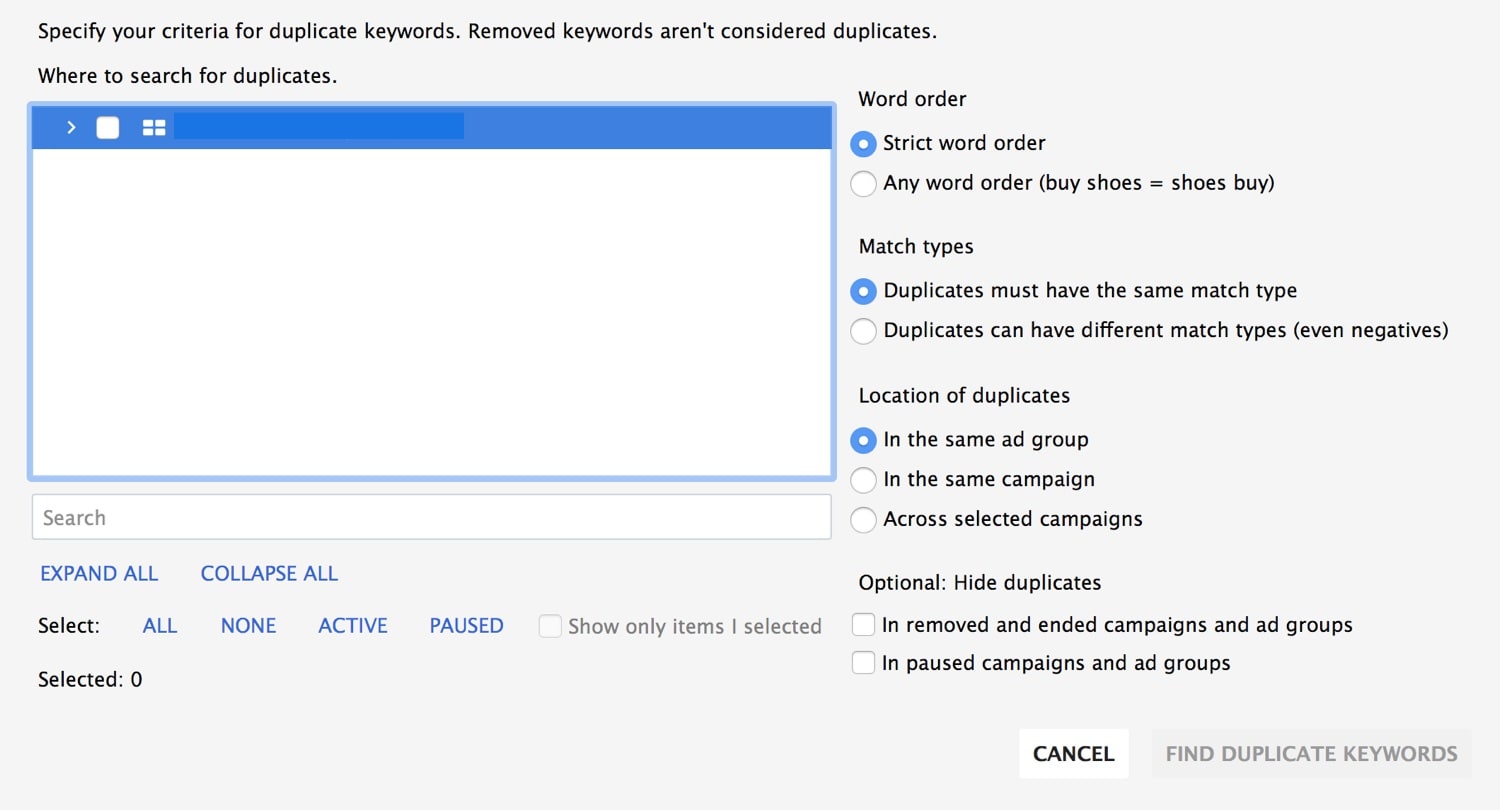
11. Use Geo-Targeting, Customer Profiling and Demographics Targeting
Google AdWords gives you the ability to target users based on their location, device, age and gender.
Study the various reports and segment your users into groups based on their location, age and gender and either increase the bid for those groups or remove users that don’t match the profile of your potential customer.
A good place to start is to analyze the Geo and demographics reports in Google analytics and decide how to apply these rules in AdWords.
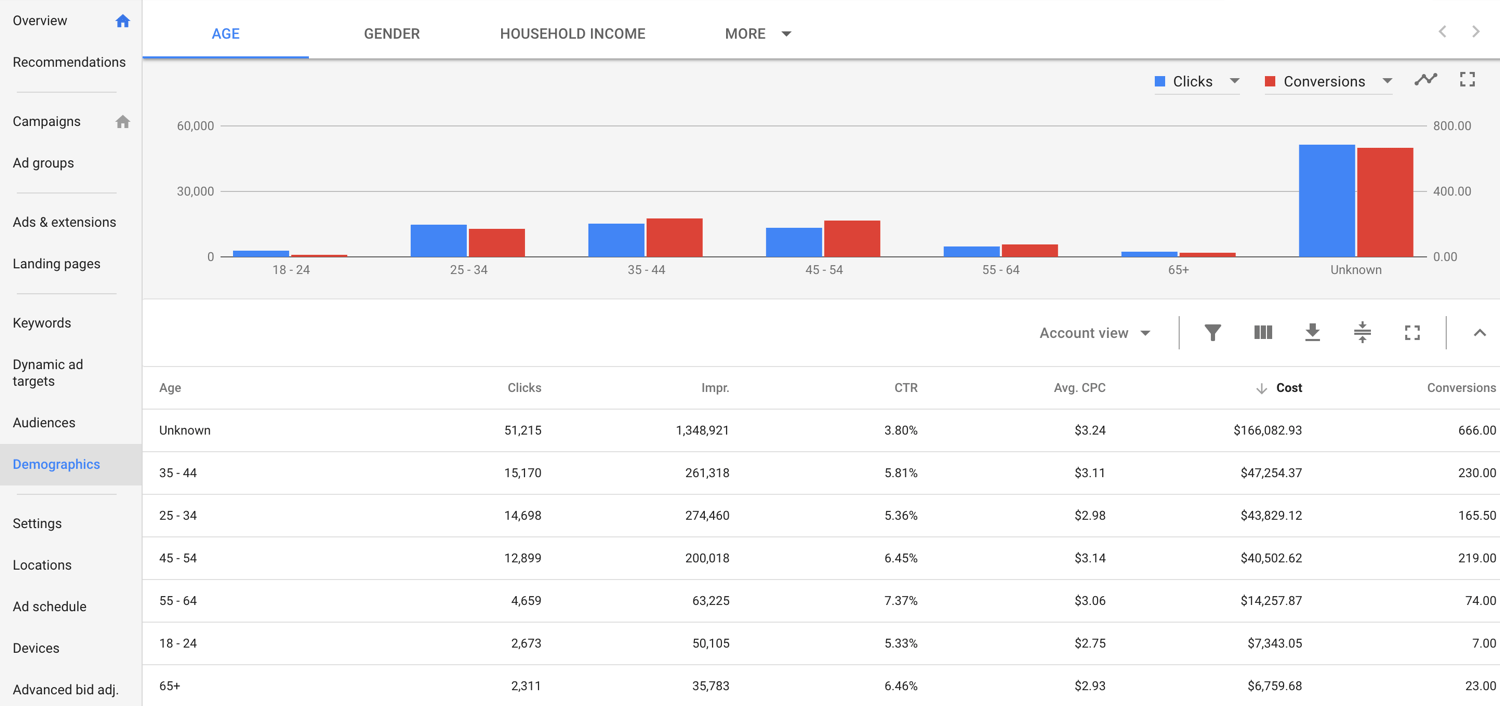
In AdWords you can find these settings under DEMOGRAPHICS and LOCATIONS. Excluding a particular age group, gender or location is simply a matter of selecting them from the list and choosing EXCLUDE.
12. Don’t always trust Google Recommendations (Opportunities)
Google is using machine learning to provide Recommendations that can increase the performance of a campaign and account in general.
While some of their recommendations are good, sometimes they may suggest actions that are not the best option for your campaigns.
My advice is not to apply their recommendations blindly but to be selective on what to adopt.
Having a spreadsheet to keep track of all changes made to a campaign, can help you reverse changes that did not generate the expected results.
13. Optimize your Landing Pages
Most people when working with PPC campaigns, they tend to spend all their time trying to optimize a campaign without thinking about the landing page.
This is a big mistake that can greatly impact your conversions.
Landing page optimization is a huge topic but three simple things you can do are the following:
First, make sure that you are redirecting users to the most appropriate landing page on your website. This might be AdWords 101 but spend some time and review your landing page URS.
Redirecting users to your homepage may not be the best option. Either create dedicated landing pages for AdWords users or improve your existing pages to be relevant to what you are promising in the Ads.
Second, examine your CTR and conversions. Find out which ads have a relatively high Click Through Rate (+5%) but a low conversion. For those ads, take a look at the landing page URL and either change it or improve your landing page.
Third, take a closer look at the bounce rate of the pages that are used as AdWords landing pages. If they have a very high bounce rate then it means that users leave your website without interacting with the page or website.
This is a signal that you need to change or optimize your landing pages.
14. Expensive products / services work better on Adwords
The last 5 years I had the opportunity to run PPC campaigns for a number of clients in different niches and the results show that AdWords Campaigns work better if you have expensive products or services to promote.
The competition is intense in almost all niches and this in turn increases the cost of getting a lead or customer from Google. Expensive products or services have a higher profit margin than low cost products and this gives enough room to run profitable campaigns.
I’m not saying that you cannot use AdWords if your products are not expensive, it can work provided that the costs are reasonable. From my experience though, we had more success promoting and increasing the sales of relatively expensive products or services.
15. Increase your Ad Spending only if it creates a Profit
Last but not least, don’t forget that the primary reason of using AdWords or any other PPC platform is to make money. If after a few months of testing, you have not reached this point then you either need to:
- Reconsider your strategy
- Get some expert help
- Forget about PPC and concentrate on other SEM channels like SEO to get traffic to your website.
Conclusion
When you visit the Google AdWords home page for the first time, it gives you the impression that you are just a few clicks away from getting customers from Google Search.
While this is not wrong, it’s not completely correct either. Yes, you can setup a PPC campaign in minutes but in order to get to the point of running profitable campaigns, it takes a lot of time and effort.
Managing campaigns on AdWords is not a task for beginners because mistakes cause money. It took us a number of years to learn how to run effective campaigns and this was the result of testing and experimenting with different settings and scenarios.
Each campaign is unique but over the years we managed to create a methodology that is proven to work over and over again.
What I have explained above, are just some of the things you need to take into account when managing your campaigns. The list is by no means complete but it covers the most common mistakes we found after auditing tens of AdWords accounts.
The single takeaway message of this post related to what you should do as your first priority, can be expressed in a single word, relevancy.
Create very specific ad groups with highly relevant keywords and ads that match what the user is actually searching on Google. Create your optimization plan, work on your campaigns and soon you will be able to run campaigns that generate profit for your business.




Hi,
Could you please guide me through the software or apps that you think are essentials for good PPC or what apps or software do you personally use ?
Thanks
Hi Harman
I’m only using SEMRUSH.
Thanks
wow these are really awesome really like your post you just made 1 more follower to your site
Thanks for the information and i like the idea that expensive products and services perform well on PPC.
Hi Akinola
Thanks for your comment. All the best with your PPC efforts
Aex
Thanks for sharing with us, keep posting.
Yes definitely. Ad extensions are a must for any AdWords PPC search campaign. Your chances of getting a click over an add are higher if you use Ad extensions, especially in search Ads.
100% true that we should not always bid for the top position, Ads on a lower position with a good title and a description and relevant ad extensions will get more number of clicks as compared to Ads on top position.
Thanks, Alex for this awesome guide.
This is really a vital information.. I got a solid point from not chasing after the top position.